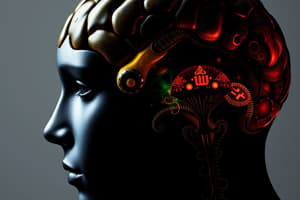Podcast
Questions and Answers
The younger the person, the faster the pulse rate and respirations.
The younger the person, the faster the pulse rate and respirations.
True (A)
Toddlers begin to recognize gender differences by observing their role models.
Toddlers begin to recognize gender differences by observing their role models.
True (A)
The head accounts for 15% of a neonate's body weight.
The head accounts for 15% of a neonate's body weight.
False (B)
The Moro reflex occurs when something touches an infant's cheek.
The Moro reflex occurs when something touches an infant's cheek.
Infants younger than 6 months are particularly prone to nasal congestion.
Infants younger than 6 months are particularly prone to nasal congestion.
________ describes how we feel about ourselves and how we fit in with our peers.
________ describes how we feel about ourselves and how we fit in with our peers.
Why is a neonate's head more 'moldable'?
Why is a neonate's head more 'moldable'?
Congenital abnormalities are the leading cause of death in which age group?
Congenital abnormalities are the leading cause of death in which age group?
At what stage do vital signs begin to level off within adult ranges?
At what stage do vital signs begin to level off within adult ranges?
Which of the following conditions is an infant most likely to have?
Which of the following conditions is an infant most likely to have?
Which age group is most likely to suffer from diabetes?
Which age group is most likely to suffer from diabetes?
The metabolic rate in the older brain does not change.
The metabolic rate in the older brain does not change.
Which of the following should be expected when you assess a 76-year-old patient's pupils?
Which of the following should be expected when you assess a 76-year-old patient's pupils?
Which of the following affects vital signs the most in older adults?
Which of the following affects vital signs the most in older adults?
Which life stage is apt to be characterized by antisocial behavior and peer pressure?
Which life stage is apt to be characterized by antisocial behavior and peer pressure?
Changes in which of the following body systems can result in the most debilitating of age-related illnesses?
Changes in which of the following body systems can result in the most debilitating of age-related illnesses?
Flashcards are hidden until you start studying
Study Notes
Pulse Rate and Respiration
- Younger individuals have faster pulse rates and respirations compared to older individuals.
Gender Recognition in Toddlers
- Toddlers begin recognizing gender differences by observing role models in their environment.
Neonate Body Composition
- The head represents 25% of a neonate's body weight, not 15%.
Reflexes in Infants
- The Moro reflex occurs when a neonate is startled, while the rooting reflex is triggered by touching an infant's cheek.
Nasal Congestion in Infants
- Infants under 6 months are particularly susceptible to nasal congestion due to immature respiratory systems.
Self-Esteem Definition
- Self-esteem refers to individuals' feelings about themselves and their perceived fit within peer groups.
Neonate Skull Malleability
- A neonate’s head is more malleable because the fontanelles (soft spots) have not fused into a solid skull; the anterior fontanelle typically fuses between 9 and 18 months.
Congenital Abnormalities
- Congenital abnormalities are the leading cause of death in neonates and infants.
Stabilization of Vital Signs
- Vital signs begin to stabilize and align with adult ranges during adolescence, with specific ranges for blood pressure, pulse, and respiration.
Airway Obstruction in Infants
- Infants are more likely to suffocate due to airway obstruction, which is influenced by their proportionally larger tongues and shorter airways.
Diabetes and Age
- Older adults are more likely to face diabetes due to decreased insulin production and metabolic slowdown, necessitating higher insulin levels.
Physiology of Older Adults
- The metabolic rate of the older brain remains constant, with unchanged oxygen consumption throughout life.
Pupillary Response in Older Adults
- Assessing a 76-year-old's pupils typically reveals slower reactions, indicating age-related changes in the nervous system.
Vital Signs and Overall Health
- In older adults, vital signs are more significantly affected by the overall health of the patient than by other factors such as diet or the immune system.
Adolescent Behavior Characteristics
- Antisocial behavior and peer pressure peak during adolescence as individuals form their identities and autonomy.
Age-Related Illnesses and the Nervous System
- Changes in the nervous system result in the most debilitating age-related illnesses, including brain weight reduction and slower peripheral nervous system function.
Studying That Suits You
Use AI to generate personalized quizzes and flashcards to suit your learning preferences.




